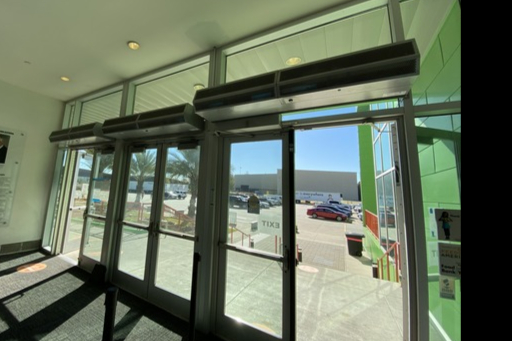Vestibules have long been a popular architectural feature in buildings, serving as a transitional space between the exterior and interior environments. However, the introduction of air curtains has presented an innovative alternative to traditional vestibules. In this blog, we will explore the concept of using air curtains as substitutes for vestibules, highlighting their benefits and considerations for enhancing building design and energy efficiency.
The Role of Vestibules:
Vestibules typically consist of enclosed entryways that provide an additional layer of protection against outdoor elements. They help control air infiltration, reduce temperature differentials, and enhance occupant comfort by acting as a buffer zone between the interior and exterior spaces.
Air Curtains as Vestibule Substitutes:
Air curtains offer an effective and versatile solution that can act as a substitute for traditional vestibules. By generating a controlled stream of air across an opening, air curtains create a virtual barrier that performs similar functions to a vestibule, such as:
- Temperature Regulation: Air curtains prevent the infiltration of outside air, reducing heat loss in cold climates and preventing heat gain in warmer regions. This helps maintain a more consistent indoor temperature and reduces the workload on heating, ventilation, and air conditioning (HVAC) systems.
- Air Quality Control: The airflow created by air curtains acts as a barrier against dust, pollutants, and outdoor contaminants, improving indoor air quality and enhancing occupant health and comfort.
- Energy Efficiency: Air curtains significantly reduce air exchange between the interior and exterior spaces, minimizing energy losses associated with open doorways. This translates into substantial energy savings and increased overall building efficiency.
- Cost-saving design: For space constrained or cost-conscientious owners/operators, air curtains offer a design alternative to repurpose the space that would have been allocated for a vestibule. This re-allocated space can be used to increase revenues and profits.
Considerations for Air Curtain Integration:
When considering air curtains as vestibule substitutes, it's important to take certain factors into account:
- Air Curtain Placement: Proper placement of air curtains is essential for effective performance. The size, height, and configuration of the entryway should be carefully assessed to ensure optimal air curtain coverage.
- Air Curtain Selection: Selecting the right type and model of air curtain is crucial. Factors such as the desired airflow velocity, noise levels, aesthetic integration, and specific environmental conditions should be considered during the selection process.
- HVAC System Integration: Air curtains can complement HVAC systems by reducing their workload. Coordination between air curtain installation and HVAC system design is necessary for seamless integration and optimal energy efficiency.
- Customization and Adaptability: Air curtain solutions can be customized to meet specific building requirements. They can be tailored for different entryway sizes, mounting options, and control systems to suit diverse architectural designs and operational needs.
Incorporating air curtains as substitutes for traditional vestibules offers numerous benefits in terms of temperature regulation, air quality control, and energy efficiency. By creating a virtual barrier at entryways, air curtains contribute to improved occupant comfort, reduced energy consumption, and enhanced overall building performance. When considering air curtain integration, it is crucial to evaluate placement, selection, integration with HVAC systems, and customization options for optimal results.
As building design continues to evolve, air curtains provide a flexible and efficient solution that challenges traditional vestibule design concepts. Their incorporation not only offers practical advantages, but also contributes to sustainable and comfortable indoor environments.




